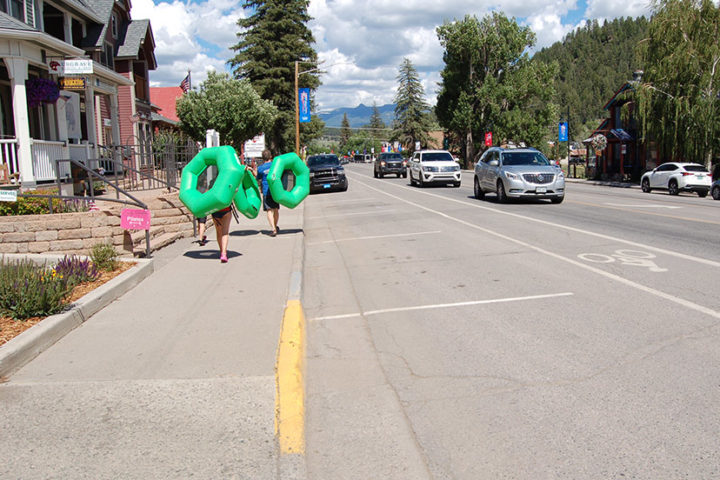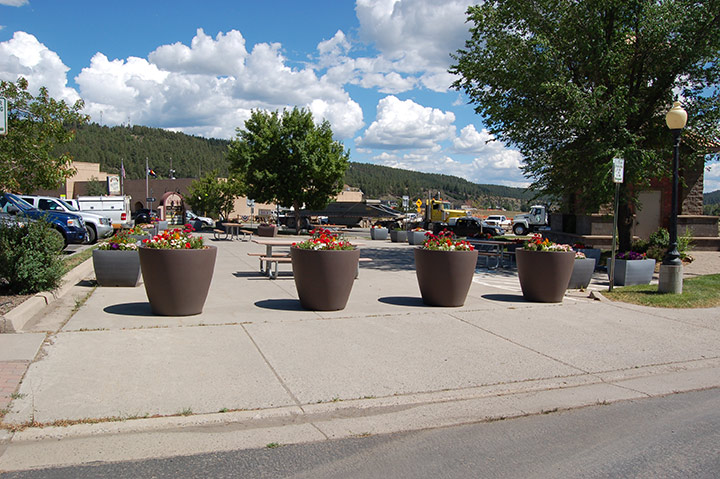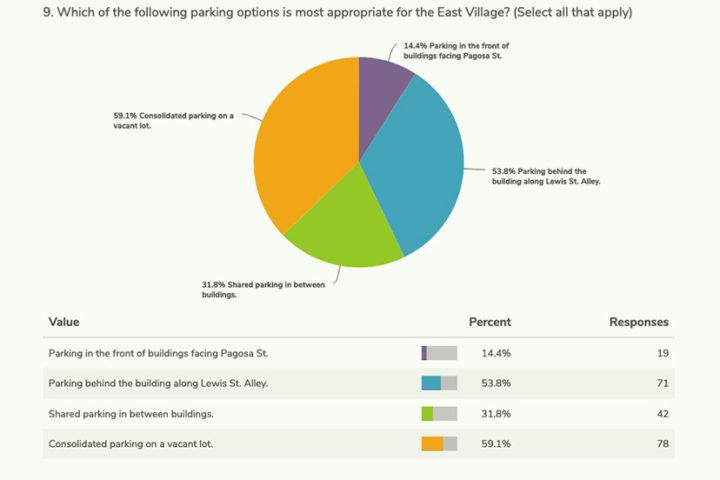Prior to the Tuesday, June 29, work session at Town Hall — where the Town Planning Commission was going to discuss the downtown parking problem — I decided to get a sense of how serious this problem might be. Anecdotally.
Rumor has it that our Fourth of July weekend generates the tourism peak here in Pagosa Springs. Whether this happens each year because our quaint, small-town Fourth of July celebration reminds folks of the good old days, when people were friendly and patriotic, or whether folks simply find early July to be a great time to take a vacation from wherever they live, I can’t say. Possibly all of the above.
But while we are suffering through our annual tourism tsunami, what is the parking situation like? Is parking a problem, during this ‘peak week’?
What’s the anecdotal evidence?
I had driven through downtown prior to the Tuesday Planning Commission work session — between 1pm and 2pm — and had surveyed the situation, looking the parking options along the public streets (Highway 160 AKA ‘Pagosa Street’, and Lewis Street). I started at the Junction Restaurant at the east end of town, and finished the tour at the Ruby Sisson Library at the west end. I found vacant parking slots on every block of downtown… and in every commercial parking lot, except for in the small parking lot at the Conoco gas station.
In most situations, I found multiple vacant parking spots.
On Thursday, June 1, I did another survey of the downtown parking situation, between 3pm and 4pm. Highway 160 through downtown was a steady stream of cars and trucks, heading wherever for the July Fourth weekend, but a ‘parking problem’ was nowhere to be seen. I counted 9 vacant public parking slots adjacent to our main commercial block — the 400 block of ‘Pagosa Street’ — and I found more than a dozen vacant slots on each of the other main commercial blocks: the 100, 200, and 300 blocks. Here’s a photo of the 200 block, taken while standing adjacent of one of our busiest downtown restaurants, Riff Raff Brewery, on July 1.
Evidence of traffic moving through town… but not exactly evidence of a parking shortage, considering the empty slots on both sides of the street.
Nor does the Town government seem especially worried about parking shortages. In fact, the Town recently installed (attractive) barriers at the centrally-located Bell Tower public parking lot, preventing cars from entering the lot. Instead, the parking lot featured picnic tables. Unoccupied picnic tables, when I took the photo.
As noted, these were ‘anecdotal’ surveys. Definitely not ‘scientific surveys’. (Who can afford a scientific survey nowadays?)
A few hours later, I was sitting in the Council Chambers at Town Hall, listening to Town Planning Director James Dickhoff discuss the ‘parking problem’. Specifically, Mr. Dickhoff was sharing the results of the ongoing “Parking Survey” posted on MyPagosa.org. The meeting had been widely advertised (we were told) because Mr. Dickhoff wanted the Planning Commission to hear from the community.
Besides myself, only two members of the public showed up for the meeting: Randall and Trish Davis, who own a couple of commercial buildings at the east end of the commercial district. (A couple of other members of the public were participating via the Zoom interface.)
I found the 1 1/2 hour parking discussion mildly depressing, because it covered the very same issues, questions, and potential solutions that the Planning Commission had discussed 18 months ago, back when I was one of the commissioners. Which is to say, the parking situation has merely grown, if anything, worse than it was in 2019. And also worse, perhaps, than in 2007, when the Town Council adopted the Downtown Master Plan to address, among other things, its parking problems.
Which is a different type of “parking problem”. The problem of inertia at the government level.

I shared my anecdotal research with the commissioners at the June 29 work session, and Commissioner Peter Adams suggested that a survey, conducted on a Tuesday afternoon in July, may not have been representative of the real problem.
“Try a Saturday,” he suggested.
Here’s Commissioner Mark Weiler, responding to that suggestion.
“Well, I did try a Saturday. And it was last Saturday. To review the parking. And I found the same thing Bill found. I was able to park everywhere.”
Commissioner Peter Hurley concurred. “I agree with you. I’ve never had a problem finding a place to park downtown.”
Commissioner Weiler:
“So, are we trying to find a solution to a problem that doesn’t exist?… Our percentage of population growth over the past 10 years is less than 2% per year. And the population sector that’s growing the fastest is ‘Over 65’.”
“I think you guys are chasing a problem that doesn’t exist. Personally.”
Ms. Davis weighed in.
“But how about the growth that’s happened in just the last year? Since people have learned that they can work remotely and have moved into town, and there’s a lot more people in town than there used to be. A lot more people buying. A lot more people using the businesses in town…”
Commissioner Weiler:
“I agree with you. But when I surveyed the parking last Saturday, I had no problem finding parking. And I took the entire day. I drove from one end of the town to the other, look around at open parking spaces. Now, I didn’t realize at the time that we have 900 potential parking spaces in reserve, based on what James has said…
“So I feel great about working on any problem, that is a real problem. This does not appear to be one.”
Of course, Mr. Weiler’s research was ‘anecdotal’. And so were Ms. Davis comments, about ‘a lot more people in town than there used to be.’ Anecdotal.
These are not ‘scientific’ comments.
The Parking Survey conducted by the Town Planning Department was also anecdotal, but in a slightly insidious sense. The survey collected the opinions of 140 members of the public (including people from Houston and Phoenix?) none of whom (I assume) had done actual scientific research into Pagosa’s alleged ‘parking problem’. But when government officials gather a mass of anecdotal opinions and convert them into ‘statistics’… they take on the appearance of something scientific.
In 2007, the Town adopted a Downtown Master Plan written by a group of thoughtful people, who had actually done research. One of the numerous recommendations, for making the downtown commercial core more vibrant, was to make public parking available at the Bell Tower Park.
The Town actually followed through with that advice.
Until this weekend.




